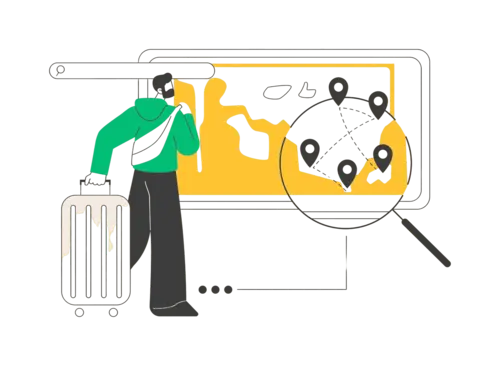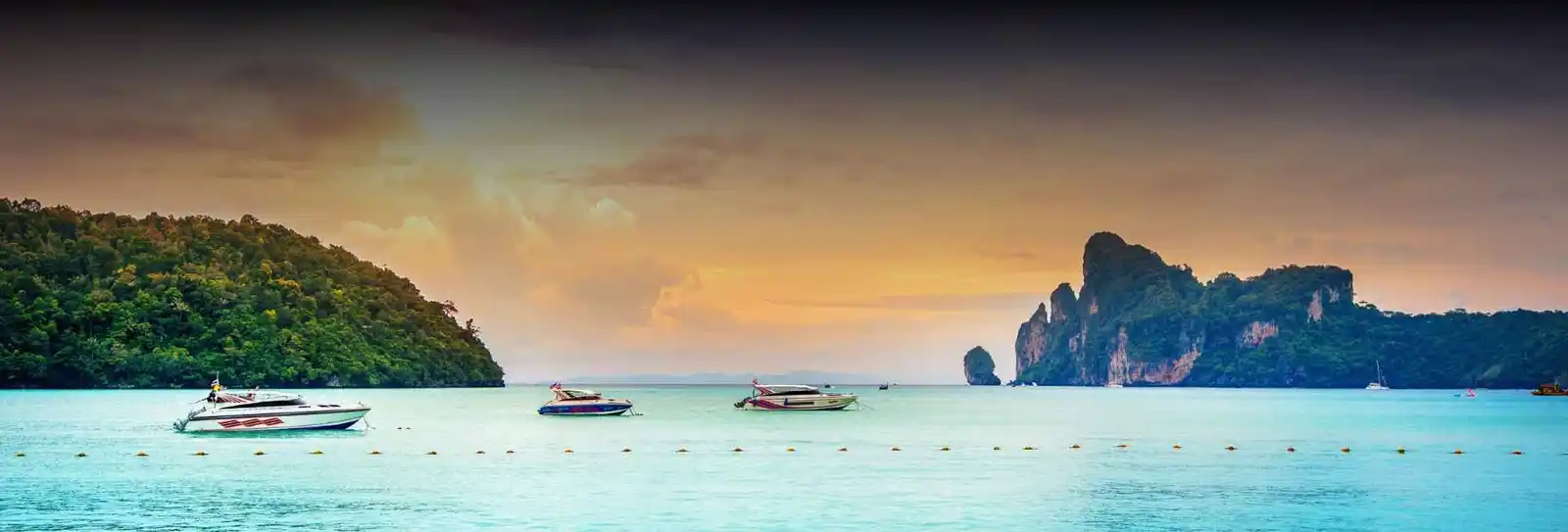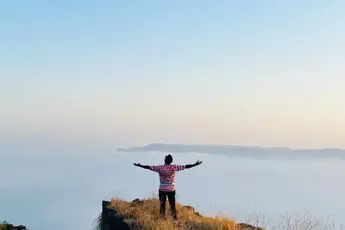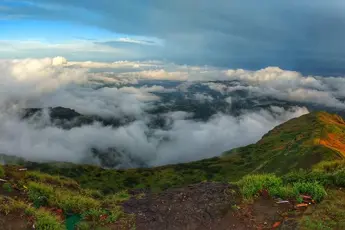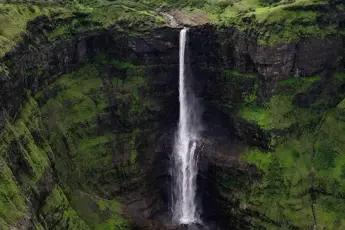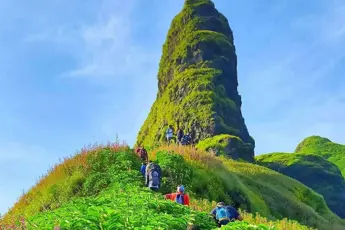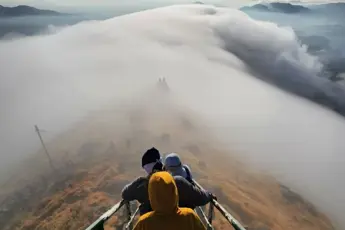
Kaas Plateau, or Kaas Pathar, is a stunning biodiversity spot in the Satara district of the state of Maharashtra, India. The plateau lies about 1,200 meters above sea level, occupying about a 10-square-kilometre extent and is renowned for the wildflower explosion of native flowers at certain periods of the year. This unique nature phenomenon becomes a rainbow of hues between August and October, attracting nature lovers, botany scientists, and nature photographers from across the nation and the globe. Kaas landscape is composed of lateritic soil, which is at the centre of conserving its rich flora. The plateau is part of one of the constituent units of the Western Ghats, a UNESCO World Heritage Site, because of its extremely high biodiversity and ecological significance. Kaas Plateau has been named after the "Kaas" tree (Memecylon umbellatum), which grows here. Unlike in common streamside or tourist destinations, Kaas is an eco-sanctuary where conservation and ecotourism are promoted. The beauty of nature's wildflowers, serene lakes, and emerald-green grasslands makes Kaas heaven for anyone who takes solace in nature's beauty.History & Significance of Kaas PlateauOrigin of the Name 'Kaas''Kaas' is the name given to the Kaasa tree (Elaeocarpus glandulosus) which overpowers in abundance at the site. Plant leaves become red during March and April and add colours to the otherwise diversified ones of the plateau. One of the most preferred selections for the plateau is 'Kaas Pathar' in Marathi nomenclature, where 'Pathar' is what plateau means as well as shares the same meaning. Kaas gained popularity and fame as it began preparing itself with its remarkable flower richness seasonally, and mobs of hordes of scientists and nature lovers visited. The name derives from the natural richness provided by nature and the unique ecological condition of the area.Historical Significance in the Context of MaharashtraKaas Plateau is among the Western Ghats' large heritage sites, which is part of the UNESCO World Heritage Sites. The area has been around for millions of years because there was volcanic activity and natural climatic conditions, and it has become highly diversified. It was a very vital grazing ground for the locals at one time and was already being farmed previously. Laterite soil and basaltic outcrops of the plateau have made it an endemic flora region. Kaas has been locally recognized in myth and ancient tradition as an important region in terms of keeping Maharashtra's ecological balance intact. The seasonal blooming of wildflowers and grasslands offers a resplendent collection of pollinators like bees, butterflies, and birds and is also of utmost significance in keeping biodiversity intact.Kaas ecosystem is especially important to botanists and conservators because of its microclimate and richness in species of over 850 flowering plant species, dominated by threatened and endangered plant species. The plateau has also played a role in the history of the hydrological cycle of the Western Ghats. It's a vast watershed that is the origin of many rivers and streams that are responsible for livelihood and agriculture in the state. Kaas must be preserved not only because of the flowering diversity but also because of the hydrological system as a whole of Maharashtra.👉 Looking for a thrilling trip near Pune? Don’t miss the chance to experience the Kaas Plateau with Escape2Explore. This guided adventure offers scenic trails, an ancient fort, and breathtaking sunrise views — perfect for weekend getaways and nature lovers.Why Kaas Plateau is a Must-Visit DestinationKaas Plateau is India's most intriguing natural wonder, and therefore a destination one cannot afford to miss for nature enthusiasts, photographers, and ecotourists. Several reasons make the plateau a much sought-after destination:Unparalleled Floral Diversity: Kaas Plateau's transformation during autumn into a botanical paradise is an eye treat. The richness of the indigenous and endangered flora species makes it a botanical living museum. Nature's rainbow beauty presents human beings with a once-in-a-lifetime experience as the plateau transforms into a multi-coloured mosaic of flowers.Scenic Landscapes: Apart from the flowers, Kaas offers serene landscapes in the form of rolling grasslands, dense cover, and serene water bodies like Kaas Lake. The natural scenery of the plateau provides scope for an excellent place for relaxation, photography, and contemplative exploration.Easy To Reach But Undisturbed: Unlike most of the biodiversity hotspots involving much travelling or trekking, Kaas Plateau is accessible by road from large cities such as Pune, Mumbai, and Satara. It is mostly left untouched by conservation efforts and organized tourism.Nature and Photographer's Paradise: The vibrantly coloured outburst of flowers, coupled with foggy horizons and otherworldly rock formations, renders Kaas heaven for photographers. Be it capturing close-up images of exotic flowers or capturing wide-angle images of the plateau, ideas never seem to fall short here for photographers.Nearby Places Kaas PlateauKaas Lake (2 km): A serene lake surrounded by lush greenery, perfect for photography and relaxation.Thoseghar Waterfalls (20 km): A breathtaking waterfall near Satara, ideal for nature lovers and monsoon getaways.Sajjangad Fort (16 km): A historic fort and pilgrimage site dedicated to Sant Ramdas, offering panoramic views.Vajrai Waterfall (14 km): One of India's tallest waterfalls, cascading down in three stages amidst scenic landscapes.Ajinkyatara Fort (25 km): A hill fort with a rich history, providing stunning views of Satara city.Mahabaleshwar (45 km): A popular hill station known for its viewpoints, strawberry farms, and pleasant weather.Panchgani (55 km): Another charming hill station with lush valleys, tableland viewpoints, and colonial-era charm.Trekking & Exploring in KaasKaas Plateau, or the "Maharashtra Valley of Flowers," is a World Natural Heritage site recognized by UNESCO in the Satara district. Kaas is renowned all over the world for its wildflower fest that makes an entirely coloured carpet-like landscape. Though Kaas is famous for its floral beauty, the place also has trekking facilities for nature lovers, adventure seekers, and photography buffs. This article deals with trekking trails, difficulty levels, trekking gear required, and nearby places that make Kaas a place one should not miss.Trekking Trails and Difficulty LevelsKaas Plateau itself is not a challenging hike, but an easy walk amidst scenery. Adventure enthusiasts can, however, extend their trekking to other trekking spots within the area that provide varying levels of challenge.Kaas Plateau Trail (Easy)Distance: 2-3 km Time: 1-2 hours Altitude: Approximately 1,200 meters above sea levelDescription: Novice and periodic trekkers' paths. The routes are properly signposted and facilitate effortless walking in the diversified vegetation. August-October is the optimal period when the flowers are fully blossomed.Vajrai Waterfall Trek (Moderate)Distance: 5 km (return) Time: 3-4 hours Altitude: Moderate climbDescription: Vajrai Waterfall is the tallest waterfall in India, dropping from a height of approximately 853 feet. The trek to the waterfall involves walking through thick forests, slippery roads, and streams and is therefore moderately challenging. Monsoon beautifies the surroundings but loads the trek with slippery and wet roads.Thoseghar Waterfall Trek (Moderate to Difficult)Distance: 7-8 km (round trip) Duration: 4-5 hours Elevation: VariesDescription: One more such beautiful waterfall in the area of Kaas is the Thoseghar waterfall. The trekking involved takes travellers through rocks and dense forests. It has to be done in the presence of a guide or team, at least during monsoon months.Sajjangad Fort Trek (Medium to Challenging)Distance: 5-6 km (back and forth) Duration: 3-4 hours Elevation: Steep climbDescription: The historic fort of Sant Ramdas Swami, a great trekking experience. The trek itself, though in certain areas extremely steep, provides the finest views of the surrounding valleys and tanks. A 'must see' for nature and history lovers looking for a spiritual break.Best Time to VisitPeak Flowering Season (August - September): Most surely the most enchanting time to see it is during its flowering season between August and September. That is when green meadows are drifting with splashes of colour when wildflowers burst into bloom in all their glory. Nature's display is a delight for nature enthusiasts, photographers, and trekkers who would love to see an otherworldly change of landscape. Part of the high-altitude regions, especially in Western Ghats, Uttarakhand, and Himachal Pradesh, also see a flower festival along vast areas of slopes, meadows, and valleys. TDecember - February (Winter): The season is characterized by enigmatic hills, blanketing the peak summits of the mountains and the valleys with heavy snowfall. Mercury drops below zero in areas such as Ladakh, Spiti, and Auli, inviting adventure sports enthusiasts and skiers much in advance. However, some of these inaccessible destinations might be shut for entry because of snowfall in volume.Spring (March-May): Spring is the culmination of winter and ushers in a new cycle of greens and nice weather. It is best suited for hill trekking, wildlife safari, and panoramic view sightseeing at hill resorts. The scenic beauty of places like Darjeeling, Manali, and Munnar can be savoured without the overcrowded tourist resorts that descend in the form of peak summer.Monsoon (June - July): Monsoon rejuvenates valleys, waterfalls, and forests and is an excellent time to tour places such as Meghalaya, Kerala, and Coorg. Landslides and traffic jams are the order of the day in hill stations, though, so one has to be careful while making plans then.October - November (Post-Monsoon & Autumn): Rains paint the landscapes blue and green sky. These months are perfect for trekking and photography. Rajasthan, the hill state of the Himalayas, and Tamil Nadu are all special during this time with very good climatic conditions and off-season tourist crowds. The most crowded locations have the most jammed traffic during peak season, which all works to distract from the beauty and serenity of the location.Essential Trekking GearWhatever the difficulty level of the trek, safety equipment is a must to make the trek successful as well as safe. The following is a list of essentials:Shoes: Trekking shoes with a good gripClothing: Quick drying moisture-wicking clothes and rain jacket (particularly for monsoon)Backpack: Light backpack with all the essentialsWater Bottle: Minimum 2 litres of water to keep yourself hydratedEnergy Snacks: Dry fruits, energy bars, and nutsTrekking Pole: Best suited for moderate to difficult treksFirst Aid Kit: Life-saving medicines, bandage, and antiseptic creamSun Protection: Sunglasses, hat, and sunscreen lotionFlashlight/Headlamp: Depending on trekking in inclement weather visibility conditionsCamera/Binoculars: To enjoy panoramic flora and fauna viewsHow To Reach Kaas PlateauTravel instructions to Kaas Plateau differ depending on one's starting point. The following is a step-by-step travel guide in detail on how to get to the Kaas Plateau via the most convenient roads:From Pune to Kaas PlateauBy Road: The easiest road route is by NH48. Pune-Bangalore Highway (NH48) to Satara and Kas Road to the plateau. It takes 136 km and 3.5 hours. By Train: Satara railway station is easily accessible from Pune railway station. Taxi or local buses can be used from Satara to Kaas.By Bus: MSRTC buses and private buses run very frequently from Satara to Pune. Taxi or local transport can be availed from Satara.From Mumbai to Kaas PlateauBy Road: The most used road is via the Mumbai-Pune Expressway, linking NH48 to Satara. The route then continues via Kaas Road after Satara. 278 km will take around 6 hours. By Train: Various trains from Satara to Mumbai. Private taxis and government bus facilities are available from Satara Railway Station to Kaas.By Bus: Very few government and private buses from Satara to Mumbai are available. Public transport facilities can be availed on reaching Satara.Why Book with escape2exploreWhen exploring Kaas Plateau from Pune and beyond, escape2explore stands out as a trusted name in adventure and experiential travel. Here’s why hundreds of travellers choose us for their getaways:Trusted, Well-Reviewed Local Operator: escape2explore has gained the trust of thousands of content tourists all over India. With persistent positive feedback and an unblemished reputation for delivering quality experiences, we assure your experience to be hassle-free, memorable, and value-packed. Our insider local knowledge guarantees that you to always be in safe hands.Seasoned Guides: Our trips are led by friendly, trained, and professional guides who are passionate about the outdoors and your safety. Whether it's a beach trek, a cultural tour, or a spiritual walk through temples, our team knows the terrain, the stories, and how to make each moment count.Safe & Curated Itineraries: Your safety is our number one priority. Each of our tour packages is thoughtfully crafted with safety measures, researched accommodations, and easy travel arrangements. We take care of the details so you can have the experience hassle-free and worry-free.Unique Experience That You Won't Find Anywhere Else: With escape2explore, you discover more than the tourist attractions. We go off the beaten track with hidden beaches, unusual treks, offbeat cultural destinations, and true interactions.Read: Andharban Jungle|Rajgad|Devkund|Kalavantin Durg|Sandhan Valley
